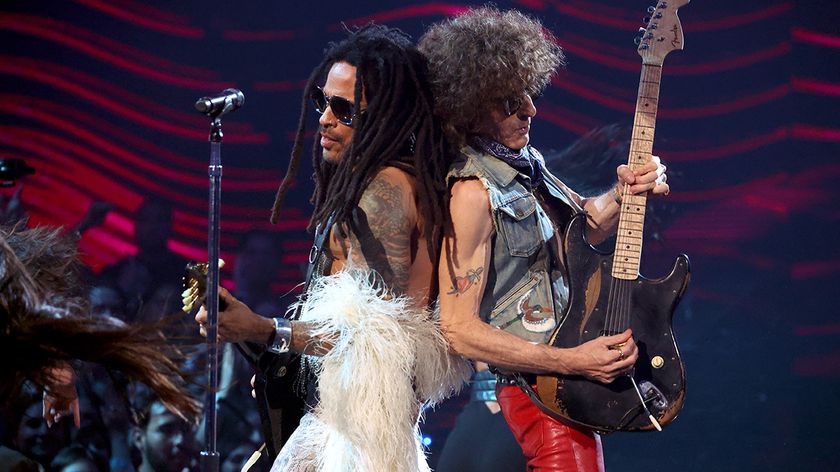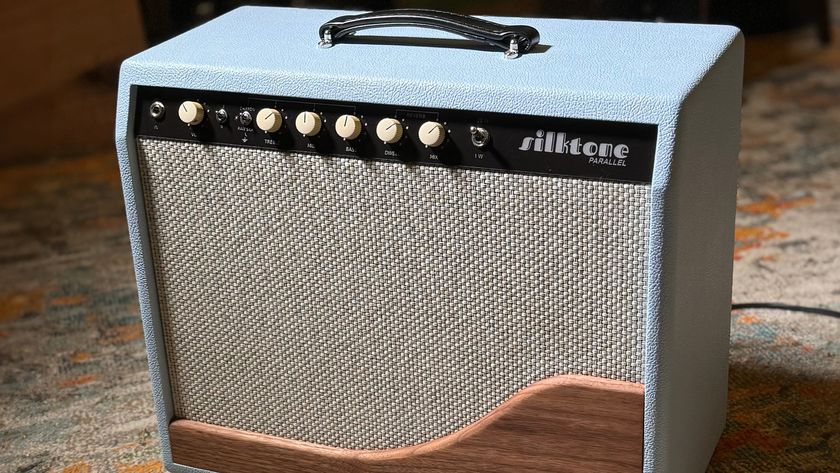Interview: Behind the Scenes with Asking Alexandria

Over the course of three years of nonstop touring, Asking Alexandria have gone from upstarts to headliners with a tight live show.
While no day is “typical” on the road, the band’s lifestyle has changed considerably.
“If you’d asked me this question a few months ago, I would have probably said, ‘You walk backstage and you’ll find myself and Cameron [Liddell, rhythm guitar] belligerently drunk, being assholes, not having a care in the world, then stumbling onstage and playing our set,” says lead guitarist/vocalist Ben Bruce.
“But now we’re a little more mature, and I don’t drink at all before I go onstage. In the past, we’ve come out looking like complete assholes, and stuff’s happened that could have been avoided if we weren’t. I thought, People come to see us, they’re paying money and supporting us, and it’s disrespectful to go onstage drunk and out of your mind and not have a care in the world. I take playing live a lot more seriously now than I did, say, six months ago, so backstage now is pretty mellow. We chill out, eat, watch a movie, maybe, and prepare for the show. We warm up and stretch for half an hour or 45 minutes, then we go onstage.”
Bruce and Liddell, joined by vocalist Danny Worsnop, bassist Sam Bettley and drummer James Cassells, ended a headline run and immediately joined Avenged Sevenfold, Hollywood Undead and Black Veil Brides for the Buried Alive tour. The itinerary took them from Estero, Florida, across the U.S. to Yakima, Washington, in a three-week stretch.
The band played a shorter set with no sound check, but performing night after night, usually the same song list, has enabled them to lock in a consistent show. “A lot of it is muscle memory,” says Liddell. “It’s fairly easy now for us because we’ve been doing it for so long. Tour is kind of like practicing every single day. You get tighter and more accurate with the riffs you’re playing. You spend a lot of time with your guitar and it’s an intense workout.”
Both men are endorsed by Ibanez: Bruce plays an FR Prestige and Liddell plays a Darkstone. They run through Peavey 6534 amps and 4x12 cabs and credit their tech, Dane Poppin, with maintaining their sound. “I spent maybe 10 or 15 minutes with them, finding the right tone, and it hasn’t changed since,” he says. “The simpler, the better. The fewer pedals you run through and quarter-inch cables you rely on, the less gear to send your signal through, the better; the purer tone you get.
Get The Pick Newsletter
All the latest guitar news, interviews, lessons, reviews, deals and more, direct to your inbox!
As a rhythm player, Cam uses a noise suppressor and tuner. That’s all he needs. He doesn’t need overdrive; he needs natural sustain and natural tone. He uses active pickups, so he’s got more gain. Ben is pretty heavy with leads and needs a warmer tone. They’ve got two different tunings, so we’ve got two main guitars for each and two backups, with one head and backup head, and one backup bass head.”
Kyle Borman has been front of house for Asking Alexandria since December 2010. After completing a tour with Powerman 5000, he received word that AA were hiring and went to England for the rock and roll equivalent of a blind date. “I didn’t know anyone,” he says. “I got on a train not knowing where I was going, no one had cell phones that worked, I arrived at a train station and out popped Sam and the tour manager. We did the tour there and kind of fell in love with each other.”
Borman has been on the road professionally for close to eight years. He began his music industry career at an early age as a drummer and soon found his calling in pro audio. “I played a lot of shows when I was a kid,” he says, “and I played clubs, but being a musician wasn’t for me. I realized I wasn’t going to make any money playing drums, because all of my friends were better players than I was, so I started recording them and doing live sound.”
During a stop on the Buried Alive tour, Borman discussed how he mixes for Asking Alexandria.
How difficult is it to get a good mix every night?
We own our board, a Digidesign SE 48. We bought it a couple of tours ago, and since then their whole sound has changed quite a bit simply because we’re traveling with our own console. It’s digital, it’s the same stuff every day, we have our own snakes and our own mics, so everything is consistent from day to day. They use Sennheiser in-ears, and what’s interesting is that I mix their in-ears from front of house on the SE 48, which a lot of bands don’t do. However, it’s been successful for us and eliminates one extra person on tour. If anything needs to be changed during their set, Dane can call me. I dial it in and tweak it and it seems to work pretty well.
What are the challenges of mixing two guitars?
Just getting the level. I don’t want the exact same tone coming out of both, because in an audio space it’s like stereo, and there’s certain placements and frequencies where things belong in a mix. If it’s all the same frequencies, it sounds like mush, but if you find the proper places, pull out on the bass and add it on the kick drum, or pull a few frequencies out of one guitar and bring it in somewhere else, then it all blends together and gives you a good sound.
How long did it take you to find that level?
Once we got our own console, I could tweak every single day to make it sound better and better. Before that, literally every day was a new day, a new console, a new p.a., everything was just brand new, so you never really, fully get the opportunity to dial in the sound that you want. You can get starting points, and by the first or second song I had it dialed in, but ever since we’ve had this digital console, things have changed tremendously.
How has this helped with changes in venue sizes?
We’re doing a lot of bigger things right now, and from arena to arena, it’s relatively all the same. It doesn’t matter if it’s 4000 or 12,000; in my opinion, it’s still an arena, it’s got the arena effect, everything is echo-y and boomy. People come in and it tightens up a little bit, your kick drum sounds a lot tighter, there’s more clarity in the sound.
Do you use much compression or EQ with Asking Alexandria?
I try to keep as minimal EQ as possible, but obviously I have gates across all the drums and light compression on the guitars and bass. I do effects on Danny, and on Ben’s vocals to sweeten it up, mostly.
How do you balance the guitars in order to bring them forward and keep the vocal out front without anything overpowering?
My guitars are slightly panned left and right and my vocals are down the center, just riding right above the music. Basically, during the whole show, I’m riding guitars and vocals. On certain spots, where it’s heavy guitar influence and it’s like a “chug chug,” I boost the guitars so you can really hear it and it’s in your face, and when it comes down to more of a vocal section, I back the guitars down and bring the vocals up.
Is front of house more technical expertise or knowing and understanding the band?
I would say 50/50 because you’ve got to know the songs. To be quite honest, I couldn’t sing you one lyric of the band because I don’t listen to lyrics when I listen to the music. I listen to melodies and I just know that the next section is going to be a slow part and Ben will come in and start singing, so I need to boost his vocal because he’s a quiet singer, or it’s a quiet part. It’s knowing which part is going on at the current time.
How much does all of this change during outdoor gigs?
We did the Warped tour and we always traveled with the same stage, we had our own board, we had the same p.a. every day, so it was all relatively the same show with little tweaks here and there. I prefer doing outdoor shows. There’s not so much echo and boominess.
You’re on second during Buried Alive, short set, no soundcheck. Can you read the room?
I don’t have time to read the room. I have to trust the system techs for Avenged Sevenfold and it has sounded great so far, so I’m confident that they have it down for the rest of the tour. We have our own snake system and everything, so even while the techs load in the other bands, we’re directly connected to our own console, so I can put in my in-ears and test everything to make sure it’s working and good to go.
The audience wants to hear what they hear on a CD. What’s the key to giving them that sound, but making it a more dynamic and powerful mix?
A lot of the parts are vocal driven, but they have a lot of techno-type stuff in their songs and it’s very powerful, so I boost it up to get people pumped up in the crowd, or I boost the guitars. I do with mixing what they do with guitars: they do a solo or slide and I’m sliding the faders up and down.
What does it take to be a good front of house?
Luck! I think, honestly, the biggest thing is a good-sounding band onstage. Shit in, shit out. If you have good equipment and good players, you can be a mediocre sound person and it will still sound fairly good, but if you’re a good sound person, it’s going to sound amazing.
— Alison Richter
Alison Richter interviews artists, producers, engineers and other music industry professionals for print and online publications. Read more of her interviews right here.
Alison Richter is a seasoned journalist who interviews musicians, producers, engineers, and other industry professionals, and covers mental health issues for GuitarWorld.com. Writing credits include a wide range of publications, including GuitarWorld.com, MusicRadar.com, Bass Player, TNAG Connoisseur, Reverb, Music Industry News, Acoustic, Drummer, Guitar.com, Gearphoria, She Shreds, Guitar Girl, and Collectible Guitar.

“We had 15 minutes left, and it was time to go… I just started playing that riff. Then Lenny goes, ‘Whoa, what’s that?’”: Lenny Kravitz guitarist Craig Ross reveals the serendipitous roots of a Kravitz classic

“The concept of the guitar duel at the end was just appalling”: Crossroads is an essential piece of '80s guitar lore, but not every guitar legend was a fan of the film









